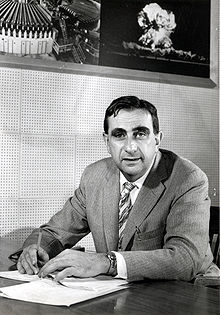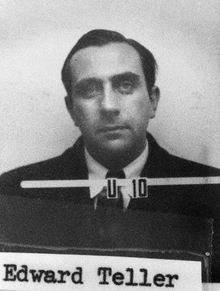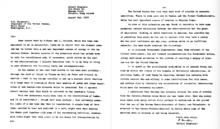Edward Teller
Edward Teller, German Eduard Teller, Hungarian Ede Teller (born January 15, 1908 in Budapest, Austria-Hungary; † September 9, 2003 in Stanford, California) was a Hungarian-American physicist. He made important contributions to a wide variety of fields in physics. He became known to a wide public as the "father of the hydrogen bomb". Teller himself rejected this title for his person.
Teller studied at the Technical University of Karlsruhe and received his doctorate in 1930 in Leipzig under Friedrich Hund and Werner Heisenberg. Because of his Jewish background, he decided to leave Nazi Germany in 1933 and emigrate to England. In 1935 he emigrated to the USA. There he became a very early collaborator in the Manhattan Project, which developed the first atomic bombs. Even during this time he was pushing for the additional development of fusion-based nuclear weapons. Many of the physicists who had worked with him in the Manhattan Project later opposed the further development of nuclear weapons technology and the subsequent nuclear arms race with the Soviet Union, while Teller vehemently advocated it because of the "threat of communism".
In security classification interrogations after the end of the war, Edward Teller incriminated Robert Oppenheimer, his former colleague at Los Alamos National Laboratory, causing him to lose much of his standing in the scientific community. However, he continued to be supported by the U.S. government as well as military researchers. Teller was one of the co-founders of the Lawrence Livermore National Laboratory nuclear weapons research center, and for several years was its director, and later deputy director.
In later years, Teller became known mainly for controversial technical approaches to both military and civilian tasks, such as a plan to create an artificial harbor (Operation Chariot) in Alaska by blasting it with hydrogen bombs. He was a prominent supporter of Ronald Reagan's Strategic Defense Initiative (SDI) and was later accused of concealing the very difficult feasibility of the program.
Throughout his life, Teller was known for both his great scientific abilities and his problematic interpersonal behaviors. He is considered one of several models for the character of Dr. Strangelove (German "Dr. Seltsam") in Stanley Kubrick's 1964 film satire Dr. Strangelove or: How I Learned to Love the Bomb.

Edward Teller (1958)
Origin, education and early years
Childhood and youth
Teller was born in Budapest, in what was then Austria-Hungary, in 1908, the second child of the lawyer Max Teller and his wife, the pianist Ilona Deutsch Teller. Teller's sister Emma was the mother of physicist Janos Kirz. The Tellers were wealthy, assimilated Jews, though their fortunes were decimated under the brief Communist rule of Béla Kun during the post-World War I Hungarian soviet republic. As a child, Teller learned to speak late in life, which is why his grandfather considered him retarded. Teller later explained this by the fact that his parents had different mother tongues. His father spoke Hungarian and only a little German, while his mother spoke German as her mother tongue and had only an imperfect command of Hungarian. As a child, he therefore had to think in two languages all the time. Edward and his sister Emmi first received private lessons from an English teacher. He then attended ELTE Trefort Ágoston Gyakorlóiskola, a renowned grammar school in Budapest. Teller later described the outbreak of the First World War and the death of Emperor Franz Joseph I with the subsequent coronation celebrations of the new heir to the throne, Charles IV, as King of Hungary in 1916 as the most impressive events of his childhood. Although he was interested in mathematics at a young age and read Euler's Algebra, for example, he temporarily lost interest in mathematics due to unpleasant experiences with his mathematics teacher.
Chemistry
After graduating from school in June 1925, Teller wanted to study mathematics, but met with resistance from his father, who considered it a "breadless" subject and persuaded his son to study chemical engineering instead. According to his mother's ideas, he should have pursued a career as a pianist. Teller studied the first semester in Budapest. While there, he entered the university's physics and mathematics competition, winning the first prize named after the Hungarian physicist Loránd Eötvös. At the beginning of 1926 Teller moved to the Technical University of Karlsruhe, which at that time had an excellent reputation in chemistry. In addition to courses in chemistry, Teller also attended lectures in mathematics and physics. He developed a strong interest in the emerging field of quantum mechanics.
Switch to quantum physics
After two years of studying chemistry, Teller finally asked his father for permission to change his course of study. The father then travelled to Karlsruhe, spoke to the professors, and the son finally received his father's consent to change to physics. Later, Teller particularly emphasized the influence of Hermann Mark, who was then a lecturer at the university. In 1928 he transferred to the University of Munich to study with Sommerfeld. However, he was not very fond of Sommerfeld. In Munich, while stepping down from the running board of a moving tram, Teller's foot got caught under its wheels, so that his foot had to be amputated. Teller remained on friendly terms with the operating surgeon Paul von Lossow, a brother of General Otto von Lossow, who had helped to thwart the Hitler putsch of 1923. For the rest of his life he had to wear a foot prosthesis and dragged the affected leg.
Doctorate with Hund and Heisenberg and assistantship
Still in 1928 he moved to the University of Leipzig to Friedrich Hund and Werner Heisenberg and received his doctorate there in 1930. The topic of his dissertation, the quantum mechanical description of the ionized hydrogen molecule, was suggested by Heisenberg. The doctoral thesis was supervised by Friedrich Hund and published in the Zeitschrift für Physik under the title Über das Wasserstoffmolekülion. In the doctoral examination Teller received the grade "I excellent" from all three examiners, Hund (physics), Paul Koebe (mathematics) and Max Le Blanc (chemistry). From 1931 he worked at the University of Göttingen under James Franck, Hertha Sponer and Arnold Eucken.
Emigration from Germany and marriage
Hitler's appointment as Reich Chancellor in January 1933 and the subsequent mass dismissal of Jewish academics as well as the persecution of the Jews did not recommend that Teller remain in Germany for any length of time, although as a Hungarian citizen he was not directly affected by the repressions that followed. So in 1933 he left Germany for England and worked briefly for Frederick George Donnan, where many scientists who had fled Germany had gathered. Teller then went to Copenhagen, Denmark, on a Rockefeller Fellowship to work under Niels Bohr. On February 26, 1934, in Budapest, he married Augusta Maria "Mici" Harkanyi († 2000), the sister of a high school friend. The marriage produced children Paul (b. 1943 in Chicago, Illinois) and Susan Wendy Teller (b. 31 August 1946 in Los Alamos, New Mexico).
Moves to the USA and turns to nuclear research
In Denmark he met the Russian physicist George Gamow. When Gamow obtained a position at George Washington University in Washington, D.C., Teller followed him in 1935 and moved to the United States with his wife. Initially, Teller conducted research in quantum, molecular, and nuclear physics. When he became a citizen of the United States in 1941, he devoted himself mainly to nuclear physics, both nuclear fission, discovered in 1938, and nuclear fusion.
Teller's most important work was probably the explanation of the Jahn-Teller effect, which describes the distortion in the geometry of the ligand field of some octahedral complex compounds along a spatial axis. Furthermore, he played a decisive role in the BET theory.
Due to his dislike of Nazi Germany and the Soviet Union, Teller participated in US military research after the start of World War II. On the advice of the Hungarian aerodynamics researcher Theodore von Kármán, who had also emigrated, he developed a theory of the propagation of shock waves together with his friend and German émigré Hans Bethe. Later, this research on the role of gas in shock waves was to prove very helpful.
.jpg)
Plate as a teenager
Manhattan Project
→ Main article: Manhattan Project
In 1938, Otto Hahn and Fritz Straßmann in Berlin discovered the process of nuclear fission when bombarding uranium with neutrons. It quickly became clear that enormous amounts of energy were released by this process. Teller received detailed information about the new discoveries in the field of atomic physics at the latest during a visit by Niels Bohr to Washington in January 1939. In February 1939 Teller was informed by his friend Leó Szilárd that a large quantity of neutrons was released during uranium fission. This seemed to raise the possibility of a chain reaction, either in the form of a civilian use as an energy-producing fuel reactor or a military use in the form of a bomb. In June 1939, Teller moved from Washington to Columbia University in New York City to work with Enrico Fermi and Szilárd on the design of a nuclear reactor for energy production.
About a month before Germany's invasion of Poland on September 1, 1939 - the start of World War II in Europe - Szilárd formulated a letter addressed to President Roosevelt that hinted at the possibility of Nazi Germany constructing a uranium bomb. Szilárd wanted the letter signed by Albert Einstein to give it more weight. Since Szilárd did not have a driver's license, Teller drove him in a car trip of several hours to Einstein's summer home on Long Island, where he signed the pre-written letter. This letter led to increased support for nuclear research by government agencies in the USA.
In 1942, Teller was invited to Robert Oppenheimer's summer planning seminar at the University of California at Berkeley, which later evolved into the Manhattan Project, with the goal of building an atomic bomb. A few weeks earlier, Teller had been talking with his colleague Enrico Fermi about the prospects for success of nuclear weapons, and Fermi had suggested that a weapon using nuclear fission could trigger an even greater nuclear reaction through nuclear fusion. Although Teller had some reasons to believe that such a reaction could not physically work, he was intrigued by the idea and would not settle for a simple atomic bomb-which at the time was nowhere near completion. In the Manhattan Project meetings, he was already talking openly about the possibility of a fusion-based bomb, which he called the "super bomb" (later the hydrogen bomb).
During World War II, he worked in the theoretical physics department at the then-secret research laboratories at Los Alamos in the U.S. state of New Mexico and strongly advocated the development of a hydrogen bomb, which lost priority when the development of a pure nuclear fission bomb was already proving very difficult. Because of his preference for a hydrogen bomb and his frustration with the appointment of Hans Bethe as director of the theoretical research department in his place, Teller refused to participate in the calculations for the implosion of the uranium bomb. This led to tensions with other researchers and the hiring of other scientists to do the work. Among them was Klaus Fuchs, who was later identified as a Russian spy. Furthermore, Teller made himself unpopular with his neighbors and colleagues by playing the piano at night.
Nevertheless, he helped decisively in the research of nuclear weapons, especially in the explanation of implosion. In 1946 Teller left Los Alamos and became a professor at the University of Chicago.

Edward Teller (photo on his Los Alamos service card during World War II).

Einstein's letter to President Roosevelt, prewritten by Szilárd.
Search within the encyclopedia